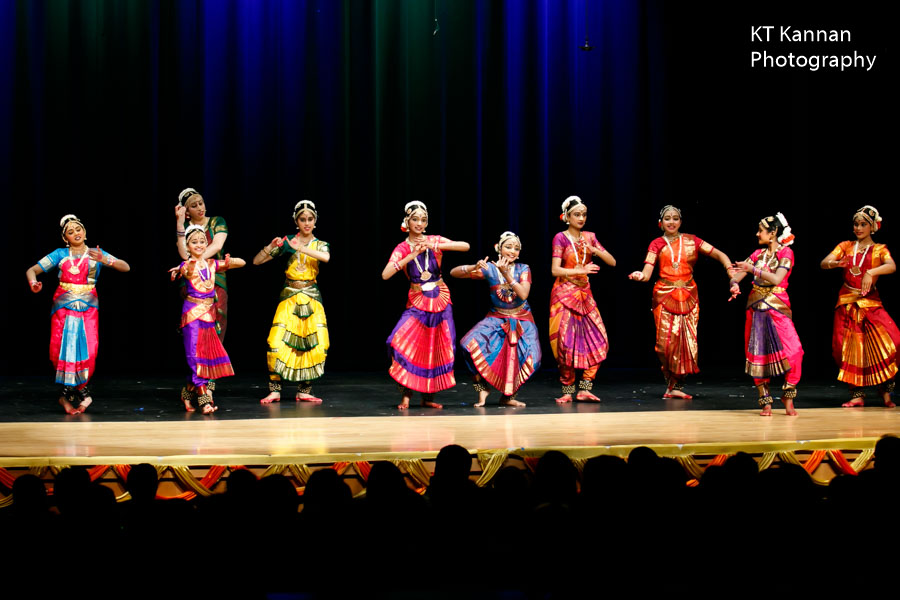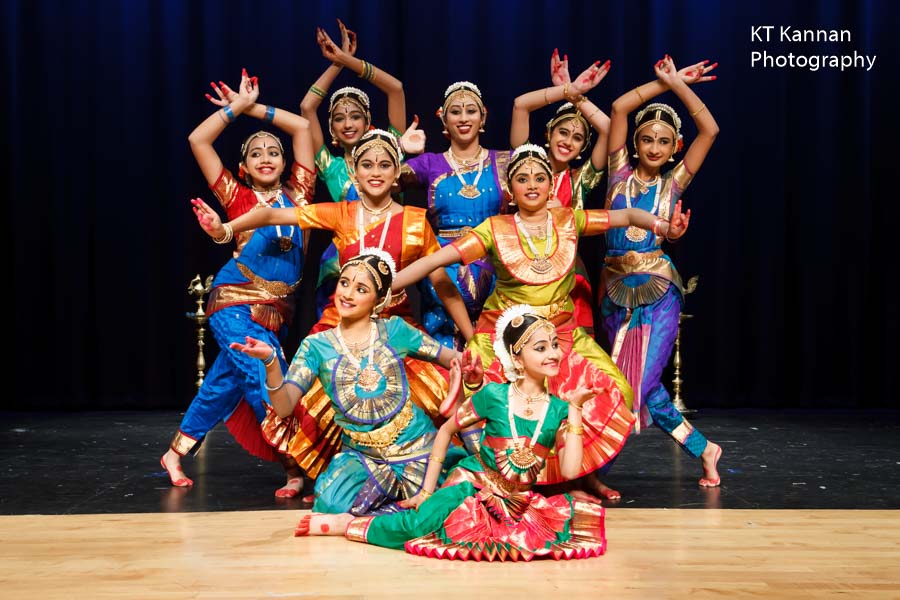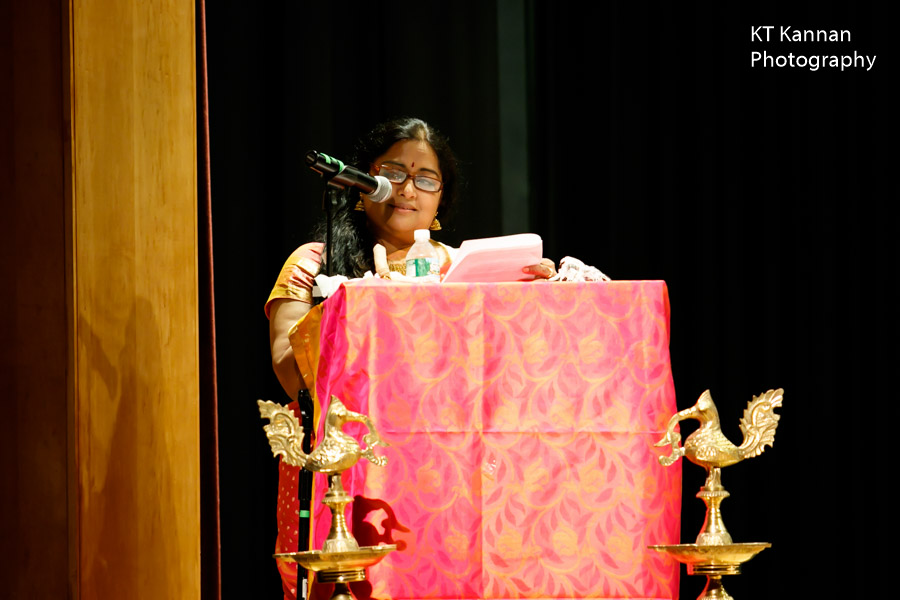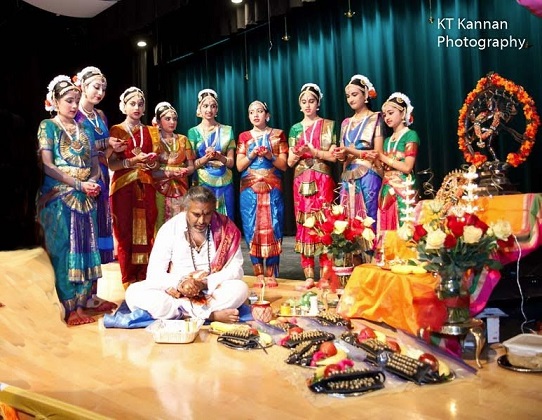Contribute
| Veena Teli Presents Salangai Pooja |
Nita Desai
06/30/2016
Bharat Nãtyam is a symbol of beauty and aesthetic perfection. As a philosophy, it is a search of the human soul for perfection and as poetry; it is a symbol of rhythmic lyricism. This is exactly what we witnessed on Sunday, June 26, 2016 at the Sharon Middle School auditorium for the Salangai Pooja. This was a novel idea created by Guru Smt. Veena Teli, Director and founder of Tarangini Creations School of Dance. She does her own gurus, Shri Pathagudy S. Ramaswamy and her Post Graduate Guru, Smt. Mrinalini Sarabhai proud by choreographing unusual and interesting pieces of original dances based on Bhajans and Krithis in her Arangetram. This event was termed the Salangai Puja, which marks the elevation of learners of classical dance from beginner to intermediate level, by letting them wear the salangai around the ankle for the first time following additional years of learning the basics of classical dance. The learners will continue down this path under the guidance of their guru until they can perform their Arangetram, a solo performance, which marks their ability to perform the dance independently anywhere. As in any classical dance form, Bharat Nãtyam requires total dedication, vigorous practice and full concentration. The nine students, Aarthi Vithianathan, Nandita Lajeesh, Sruthelaya Mohan, Tulasi Vithianathan, Jananai Elumalai, Kavana Girish, Anusha Bhatia, Raga Chilakmari, and Shreya Jadav, displayed a mastery of the technique of movements, and in doing so were graceful, supple, exhibited physical endurance, and a faultless sense of rhythm. They certainly received the blessing of this author to continue on their path.
After a warm welcome on this auspicious occasion from the Guru Smt. Veena Teli, the resplendent teach explained in a profound manner the meaning of Natya, Salangai Puja and the concept of NATYA as an Acronym. The N stands for Nada meaning sound, the origin of both the Universe and dance, highlighting the critical harmony of movement and sound. A stands for Agnostic, as the dancer should not have likes and dislikes of any dance. T for Transendence, the elevation of oneself from the present state to a state that is many levels above, like achieving Samadhi – an eternal state of bliss. In dance, Transendence is not just for the dancer, but for the spectators as well. Finally, the Y stands for the dancer’s yearning. Yearning to dance and having a passion for it are important. Smt. Teli thanked two people without whose dedication, the event would not be such an astounding success and these ladies were Varshini and her mother Sarita. Varshini, one of Veena’s students, has been a teacher and a friend to the dancer.
It was great to see her evolve from a dancer to a teacher. Her mother Sarita, also played integral role as the CEO of this event –planning, makeup, dressing, decorations, photography and food were handled beneath her careful guidance.
Once presented with these lofty concepts, we were plunged into the dance realm with the presentation of Pushapanjali, a song in which the dancers present flowers to the Gods. The nect dance was Ganesh Gautham. In the dance the dancers worship Lord Ganesha, the remover of all obstacles. The dancers welcomed their audience, and took their Guru’s blessings. There was a uniformity of style among the 5 older students. Moreover, they danced energetically and were well synchronized in their movements. The second Pushpanjali was the “Natesha Kauthuvam,†a dance in praise of Lord Shiva, the god of destruction as well as the god of dance in his 'Nataraj' form. This was a fast paced piece that featured the beautiful poses of Natesha (Shiva), he who is worshipped by all the sages and demons, who dances with a drum in one hand. In a Kauthuvam, the rhythmic syllables are intertwined with the lyrics of the song. It has both nritta and abhinaya components in its choreography. The four younger students who performed this were expressive and enthusiastic and gracefully depicted the poses of Natesha. The two Alarippu pieces represent the blooming of the dancer, from a tiny bud to a beautiful lotus. The first Alarippu was set to an uncommon 13 beat talam and the second set to a 7 beat. The dancers concentrated on rhythm, using technical style and displaying head, eyes, and neck movements combined with vibrant footwork.
In the Jawatiswaram: Raga,Saraswati, each student’s solo performances engaged the audience, who were rapt with their unique style, movements, and technical steps. The next dance was Jatiswaram: Bilahari, Nritya, or pure dance, combined the jatis, or rhythmic syllables, alternating with swaras, or musical notes. The Shabdam: Thandai Muzhanga showed an easing of both Nritta & Abhinaya, creating an entrancing spectacle. It depicted the life of Lord Muruga from his childhood, to his marriage to Valli through lyrical storytelling and jatis alternating with shabdas. This dance was performed by all 9 students, and brought a vibrant end to the first half of the event. The short Intermission allowed a break for the dancers and the audience enjoyed the delicious Onion Bhajias and Prasadam of Boondi Ladoos with Elaichi Tea, Water, or Mango Lassi kindly provided by the parents of the students. The Maale Manivanna featured the younger students wearing garlands meant for prayers to Lord Vishnu by his devout disciple, Saint Andal. The bhajan Ramachandra Kripalu, narrating Shri Rama’s life, was extremely well received by the audience as it was an unexpected and novel dance. Similarly, the Krithi: Dolayam Chala Dolayam described the ten avatars of Lord Vishnu starting with the dola, swing; and seva, tone. The choreography for both these numbers was superb.
The rest of the items: Kuzhaloothi Manamellaam, Tillana, Naadha Vindu Kalaadi were performed with grace, litheness, and expressiveness. Soon came the end of the program, which typically ends with Mangalam, the prayer song from the Thiruppugaz. The dancers thank God, their Guru, and the audience, marking the end of a wonderful evening that we were fortunate to be a part of. Even though there were nine students, the dances were synchronized, well choreographed, and well practiced. Kudos to their Guru for coordinated a well managed Salangai Puja. After the handing of the certificates, each girl had the opportunity to say a few words. The final words were about the credit owed to their Guru Veena Teli for her inspiration and motivation and one of the parents gave a “Thank You†speech. The guru’s “You can do it!†magically transformed into dances par excellence. Even the parents were astonished at their daughters’ proficiency and beautiful movement. It was a treat for us, the audience. This marked an end to a wonderful Salangai Puja, a tribute to the Gods.
You may also access this article through our web-site http://www.lokvani.com/



